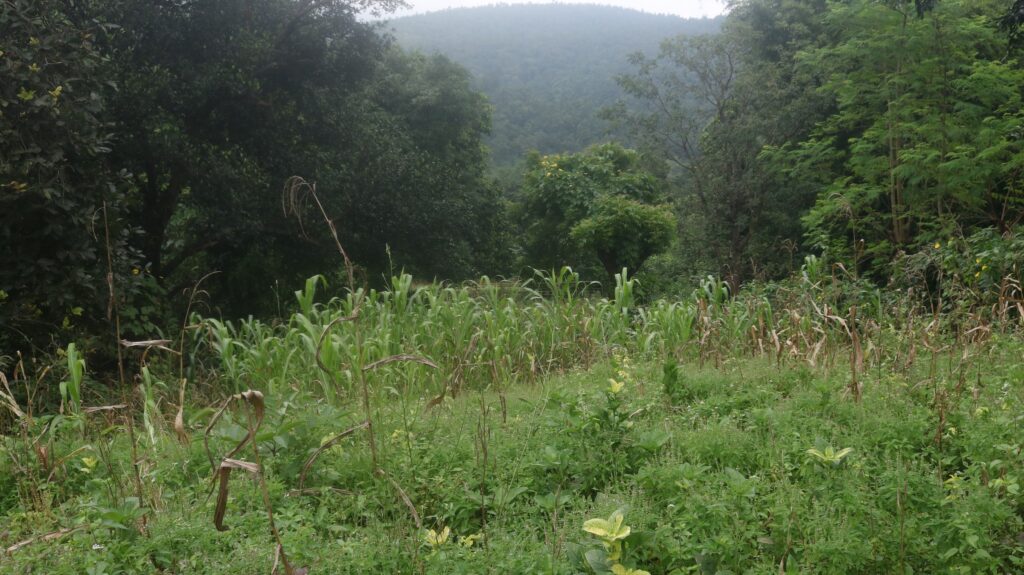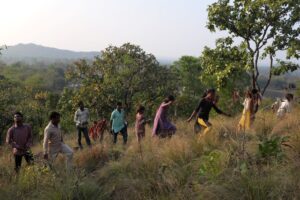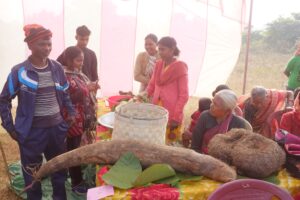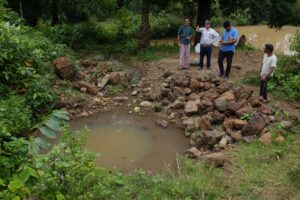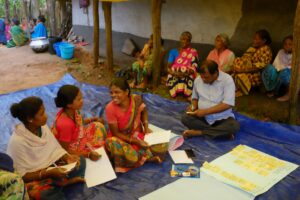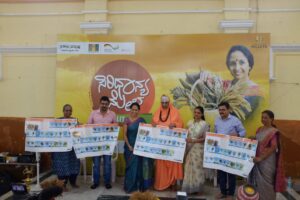Budheswar Mahato, Jagabandhu Sanda and Rohan Mukerjee
The landscape of the Saraikela area in Saraikela-Kharswan District, Jharkhand is a study in contrast. As one travels through the Adityapur and Gamaria industrial belt often overwhelmed by exhaust fumes, emissions from the numerous factories it is difficult to imagine that hardly ten kilometres away are forested hills where life goes on largely like it did during the rule of Raja Bikram Singh who established the state of Saraikela in 1620. The Bandi Pahar Jungle and Sera Pahar Jungle in Saraikela and Gamaria Blocks comprise of rich native Sal (Shorea robusta)forests with other prominent tree species being Asan (Terminalia alata), Kendu (Diospyros melanoxylon), Pial (Buchanania cochinchinensis) and Bhela/Bhelwa (Semecarpus anacardium).

These forests are home to a number of Adivasi and other forest dwelling communities which include the Bhumij, Munda, Santal, Ho, Paharia, Lohar and Mahato. Keystone has recently commenced work in 5 villages in this area through a fellowship to Community Resource Person Budheswar Mahato from Hatnada village. Through a project from Both Ends Keystone is promoting Agroecological approaches, revival and strengthening of traditional food systems.

The livelihoods of the residents of Bandi Pahar and Sera Pahar primarily revolve around Agriculture and forest produce, though there has been an increase in dependence on wage labour and migration. The average agricultural land holdings are small and vary from around 1 acre to 5 acres. There is a small percentage of landless households, but they are mostly recent entrants and even they have small homestead plots. Paddy is the primary Kharif crop with research carried out in Hudu and Mathkomdih Panchayats revealing that in the past around 67 local paddy varieties were cultivated. However, the number of paddy varieties cultivated has declined considerably and currently only around 15 to 20 varieties are cultivated on a regular basis. These include 2 varieties of Goda Dhan (Upland Paddy) – white and red, and variety of black rice known as Bhoot Muri Dhan. In the past farmers in the area cultivated several other Kharif crops however, in the past decade the cultivation of many of these crops has declined and several crops have disappeared from the area. Crops that have disappeared from the area include Kodo millet, Madua (Finger millet), Til (Sesame), Moong (Green Gram). Others like Gangai (Sorghum), Makkai (Maize), Kudrum (Roselle), Kurthi (Horse gram), Biri (Black gram), Sutri (Rice bean) and Romha (a variety of cowpea) are still cultivated but in smaller quantities than in the past. However, despite the decline in cultivation of these crops some farmers like Ramchandra Sardar, from Tirildih Tola / Hamlet of Janglikhas village, still cultivate a diverse mix of crops and he proudly showed me his fields where he was cultivating Kurthi and Bihi.
The Rabi crops cultivated include Sarso (mustard) and Sakarkanda (Sweet Potato). At one-point Sakarkanda was cultivated in substantial quantities and Sardarbera village in particular was renowned for its Sakarkanda. However, of late there has been a decline in the cultivation of Sakarkanda.

Forests and streams play a vital role in the agricultural practices of the farmers in the villages of Bandi Pahar and Sera Pahar. As Mangal Munda a framer from School tola, Janglikhas village, shared the leaf litter and humus brought down from the adjoining forests by streams and rains ensures the fertility of their agricultural lands. As a result, none of the villagers in Janglikhas need to use chemical fertilisers like Urea and DAP. The surrounding trees and forests also ensure adequate moisture content that the crops require.
In addition to paddy cultivation all households also cultivate diverse variety of crops in their Kocha Badi (homestead plots immediately adjoining habitation) and Badi (larger homestead area). Their homestead plots range from 2 Katha (4 decimal) to 10 katha (20 decimal). The Kocha Badi or Badi is an excellent example of multilayer mixed cropping with creepers and greens grown in the understory, maize and sorghum in the middle and upper story and trees and bamboo surrounding the plot. The principal crops cultivated include Yellow Makka (Maize), Kudrum (Roselle), Begun (Brinjal), Tamatar (Tomato), 4 to 5 types of Mirchi (Chilli), Karela (Bitter gourd), Ghee Karla (wild spine gourd), Nanua (sponge gourd), Kundru (Ivy gourd), 2 types of Khera (cucumber), 5 types of Shim (flat green beans), 3 types of Kohonda (Pumpkin), 3 types of Jhinga (ridge gourd), 3 types of Lau (Bottle gourd). A variety of greens like Pui saag (Indian spinach), Lal saag (Red spinach), Harra saag, Dhanta Saag. A variety of root and tuber crops are also cultivated, and they include 2 types of Mula (raddish), Sakarkanda (sweet potato), Susni aloo, Kham aloo (Greater Yam), 3 types of Haldi (Turmeric), Ol (Elephant foot yam), 3 types of Kochu (Taro), Man Kochu (Giant Taro), 2 types of Aalti.

A variety of wild greens and uncultivated food plants are also found in and around the Kocha Badi. These include Kaanta Saag, Sirkitia, Kana Saag, Khapra Saag, Chaal Dua Saagm Beng Saag, Dhela Saag, Susni Saag, Kuiliakhada, Bhrami / Chida Saag. Hanjet Begun / Jangli Begun / Biroti a wild vegetable plant has small round fruits and white flowers and is eaten as a vegetable. Cooked along with ghee it is used to prevent cough.
In addition, there are several tree species found in and around the Kocha Badi. These include 2 varieties of Kaala / Banana, 2 to three types of Papaya, Kathal / Jackfruit, Munga / Drumstick, 2 types of Lemon, Amrut / Guava, Sitaphal / Custard Apple, 4 to 5 types of Aam / Mango, Jamun / Java plum. A number of wild or uncultivated tree species are also found alongside the cultivated varieties and these include Kudol (Bahunia purpurea), Gamhar (Gmelina arborea), Neem (Azadirachta indica), Mahua (Madhuca longifolia), Kusum (Schleichera oleosa) and Karam (Neolamarckia cadamba). 3 to 4 varieties of Bamboo are also grown around the Kocha Badi and they are put to a variety of uses by the villagers. One of the bamboo varieties known as Rutu Madh is used to make a flute which is used by the local communities during their traditional cultural dances and ceremonies.

One of the most striking plants found in the Kocha Badi is the Man Kochu or Greater Yam (Alocasia Macrorrhizos). With the largest un-split leaf in the world the Man Kochu stands head and shoulders above a majority of the crops in the Kocha Badi. Man Kochu is a shade tolerant plant with its’ giant leaves adapted to absorbing the small amount of light that reaches the rainforest floor under the dense tree canopy, which makes them ideally suited to the Kocha Badi which is often dark and shady owing to the large number of other crops and tree species cultivated here. The stem is consumed as a vegetable when tender. The villagers also consume the corm after frying it thoroughly in oil. In the raw state, the giant taro is poisonous to humans if eaten in large quantities, until prolonged boiling removes the toxin calcium oxalate. The villagers were aware of this and shared that if not fried the corm causes irritation in the throat and even after frying, they consume it in moderation. They also fry the corm in ghee and use it to address throat ailments like cough, soreness, and irritation.
The Kocha Badi and Badi are an important source of a diverse variety of crops that help meet the food and nutritional needs of the local communities for a large portion of the year. One of the benefits of the fact that mostly local varieties are cultivated in the Kocha Badi is that these varieties are less susceptible to pest attacks and infestation as compared to hybrid and high yielding varieties. As a result, villagers can deal with pests using local and organic remedies application of ash to brinjal plants to keep the pests at bay, pest repellants made from neem, Karanj and other locally available leaves. One of the challenges faced with regards to maintaining the Kocha Badi throughout the year is that during the 4 months of the summer season the villagers experience acute water scarcity and even accessing drinking water becomes a challenge. However, despite this a few crops like Begun, Papita, Kundri, Mirchi and one or two greens are still available. Mukto Munda a woman from Hatnada village shared that the women must source water from considerable distances for their Kocha Badi during summer months.
While the farmers in Bandi Pahar and Sera Pahar still cultivate a diverse variety of crops, unfortunately the region has been experiencing a steady decline in crop diversity of the last decade or some. Jaghbandu Sanda, a consultant working with Keystone Foundation, who has been working with farmers in this area for around two decades shares that the region has witnessed a startling decline in and loss of a number of crops and crop varieties in the last decade. He points out that several important local crop varieties cultivated in the villages of this region have either been totally lost or have witnessed a substantial decline in quantities cultivated. Some of these varieties include Lal bhindi, pui saag, desi Jhinga, desi barbatti which comprised of 3 varieties that ripened at different times, kaanta begun, a local tomato variety which is very fleshy with a thin skin. Budheswar shared that when villagers migrate for wage labour and other work, they come across high yielding and hybrid varieties of crops and are very impressed with the yields and are tempted to bring these varieties back and cultivate them in their lands. He shared that the villagers are mostly influenced by the large-scale cultivation of hybrid vegetables, paddy, pulses, and other crops in Tamar Block of Ranchi District. Despite not having an understanding of the long-term impacts of chemical input intensive cultivation of hybrid crops some villagers have started to cultivate these crops. This is posing a serious threat to the survival of diverse local crop varieties as other farmers are also beginning to switch to hybrid crops tempted by the higher yields. However, the negative impacts of hybrid crops are also slowly coming to the fore. Farmers are experiencing a decline in the fertility and quality of the soil in their lands and are being forced to spend more and more on chemical fertilisers. Also, hybrid crops are more susceptible to pests and climate change. If rain does not come on time then hybrid crops are negatively impacted and their productivity declines. Moreover, if hybrid crops are infested by pests or disease then it is very challenging to mitigate this and their productivity plumets. Comparatively local crops are far more hardy and are able to withstand erratic monsoons and pest infestations better than hybrid crops. Budheswar pointed out that 2022 was a year of very low rainfall with Saraikela and many other parts of Jharkhand witnessing drought like conditions. Farmers who had cultivated hybrid crops were hit hard as a result of the low and erratic rainfall and face major crop losses. However, while those who cultivated local crops faced some losses on the whole, they had a better harvest.

Keystone Foundation through the efforts of Jaghbandhu Sanada and Budheswar Mahato is promoting the revival and strengthening of traditional agriculture and mixed cropping practices. They are carrying out a variety of awareness and training programs to emphasise the importance and benefits of traditional agriculture and associated local crop varieties. Several local and climate resilient varieties of crops have been distributed to farmers and they have successfully cultivated them in their fields and Kocha Badi and Badi plots. Cereal and pulses like Madua / finger millet, Gundli / little millet, Makkai / Maize, Rahar / Pigeon pea, Kurthi / Horse gram have been distributed. A variety of vegetables and greens were also distributed. Budheswar also conducted a training program on preparation of organic pesticides and pest repellents. Despite the challenges and temptations to adopt modern chemical intensive agricultural practices a majority of farmers are coming forward to protect and conserve their local crop varieties and traditional agricultural practices. The establishment of a community seed bank of local seed varieties and a resource centre for bio inputs is being explored. There is also a need to explore and make available sustainable and viable livelihood avenues based on organic and traditional agricultural practices and forest products. This will go a long way in incentivising the continued protection and conservation of forests and natural resources in Bandi Pahar and Sera Pahar.

